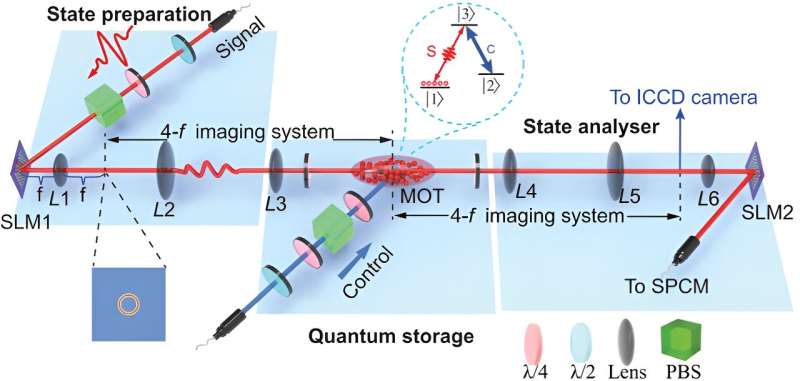January 15, 2024 feature
This article has been reviewed according to Science X's editorial process and policies. Editors have highlighted the following attributes while ensuring the content's credibility:
fact-checked
peer-reviewed publication
trusted source
proofread
A new approach to realize highly efficient, high-dimensional quantum memories

Many physicists and engineers have been trying to develop highly efficient quantum technologies that can perform similar functions to conventional electronics leveraging quantum mechanical effects. This includes high-dimensional quantum memories, storage devices with a greater information capacity and noise resilience than two-dimensional quantum memories.
So far, developing these high-dimensional memories has proved challenging, and most attempts have not yielded satisfactory efficiencies. In a paper published in Physical Review Letters, a research team at University of Science and Technology of China and Hefei Normal University recently introduced an approach to realize a highly efficient 25-dimensional memory based on cold atoms.
"Our group has been using the orbital angular momentum mode in the space channel to study high-dimensional quantum storage and has accumulated a wealth of research experience and technology," Dong Sheng Ding, co-author of the paper, told Phys.org. "Achieving high-dimensional and high-efficiency quantum storage has always been our goal."
In their previous studies, Ding and his colleagues found that the singular properties of a spatial pattern known as the perfect vortex optical field could be particularly advantageous for the development of high-dimensional quantum memories. This inspired them to leverage the mode-independent interaction between light and matter associated with this pattern to realize high-dimensional and efficient quantum storage.
"The basic principle of our storage device is based on the electromagnetic induced transparency phenomenon, which is the interaction between light and matter," Ding explained. "In simple terms, the signal photons are slowed down to zero velocity in the medium and stored for a period of time. Then, the stored information of signal photons can be retrieved by the control light."
The quantum system created by the researchers is made up of signal photons, a control light beam, a Rubidium cold atomic ensemble that serves as the storage medium and a spatial light modulator that encodes and decodes high-dimensional quantum information. The team's memory encodes high-dimensional information on the signal photons, ultimately realizing the high-dimensional storage of information in the medium.
"Prior to our work, efficient quantum memory was limited to two-dimensional storage quantum systems," Ding said. "The advantage of our work lies in extending the storage dimension from two to 25, allowing for the preparation of high-dimensional memory that operates in high-dimensional Hilbert space. This not only greatly expands the capacity of the memory and increases the transmittable capacity of quantum communication but also has potential implications for fault-tolerant quantum computing."
In initial tests, the researchers demonstrated that their quantum memory can store 25-dimensional high-dimensional states. Notably, however, their system can also store arbitrary high-dimensional states ranging from 1 to 25 dimensions (i.e., including 3-dimensional, 5-dimensional, 10-dimensional states, and so on).
"Our results demonstrate the compatibility of our memory with programmable high-dimensional quantum states in the range of 1 to 25 dimensions," Ding said. "In addition, we have theoretically analyzed the scalability of our memory's dimensionality. By further optimizing the optical path design, we can achieve efficient storage of up to 100 or even higher-dimensional states, showcasing the unique advantages of our high-dimensional storage scheme."
The recent work by Ding and his colleagues introduced a new highly promising method to achieve efficient high-dimensional quantum storage. In the future, this approach could be used to create various high-dimensional quantum memories, which could in turn help to realize other quantum technologies, such as high-dimensional quantum repeaters.
"Notably, through our approach, it is possible to realize a practical high-dimensional quantum memory," Ding added. "In the future, we will establish high-dimensional quantum repeaters using high-dimensional quantum memories, enabling high-dimensional quantum communication between two or more remote quantum nodes."
More information: Ming-Xin Dong et al, Highly Efficient Storage of 25-Dimensional Photonic Qudit in a Cold-Atom-Based Quantum Memory, Physical Review Letters (2023). DOI: 10.1103/PhysRevLett.131.240801
Journal information: Physical Review Letters
© 2024 Science X Network




















